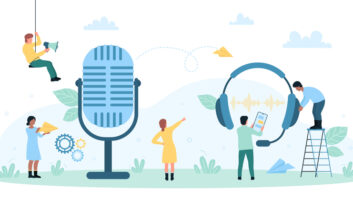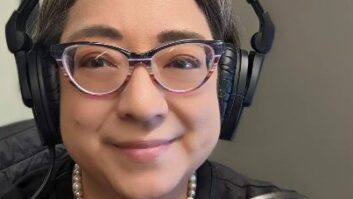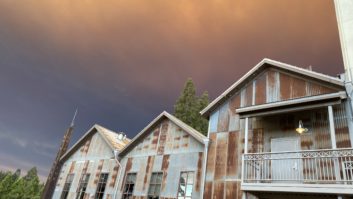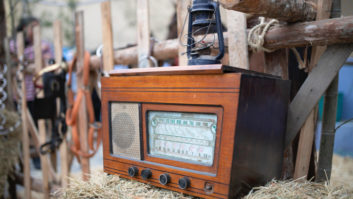Text has been updated to correct information from the Association of Independents in Radio and Sue Schardt.
There is a something of a revival going on at the National Federation of Community Broadcasters, which is celebrating 40 years of service.
CEO Sally Kane’s call for stations to “create unity in local communities” resonated throughout the NFCB Community Media Conference in Denver in June. As NFCB put it on its website, the conference covered a range of topics such as journalism, digital strategy, development, fundraising and engagement.

LPFM Summit participants from around the country posed for a “victory snapshot” at the end of the conference’s first day. They heard from experts about operating requirements, regulatory compliance and tips and experiences from fellow LPs.MAKERS
At most national broadcasting conferences, diversity among attendees remains a challenge, though this has been improving slowly over many years. But at NFCB16 one couldn’t help but notice the striking diversity among 247 attendees hailing from 38 states, Puerto Rico, Canada and Denmark.
Wednesday featured half-day workshops for dozens of newcomer low-power FM stations as well as for more-established Native American and Latino broadcasters. The conference offered crosscutting tracks for administration, operations and content as well as a novel interactive “Makers Intensive” track focused on integrated digital strategies being practiced at energetic stations.
Designed as a stimulus for others, “Makers” focused on what these innovators are doing in the multi-skilled media environment. It featured an in-depth look at the open source “Audience Engine” initiative at WFMU that provides tools and templates for community building, fundraising and cross-platform publishing. [See RW’s 2015 story at radioworld.com/wfmu.]
Kane, a veteran of community radio and student of change management theory, came to NFCB as CEO in 2014; her job includes a mandate to identify essential services needed for stations “navigating the technological demands and opportunities of the digital age and severe economic downturn.” Kane opened the conference with a plenary session. Panelist Erika Pulley Hayes noted that in an era when Uber, the largest cab company, doesn’t own cars, and Facebook, the largest content provider, doesn’t make content, all stations need to think critically about their roles in their communities.
Mike Henry of Paragon Research set the table with a reality check that only 12 percent of Americans listen to noncommercial radio and that among the 776 community radio stations, over half are in rural areas where they are often the only local radio presence in economically challenged communities.
Mike Henry of Paragon Media Strategies reviewed challenges and opportunities for community radio (here, in a slide based on “The Infinite Dial 2016” from Edison Research and Triton Digital). He told attendees that audiences now have continuous access to digital media on a multitude of devices, so community radio needs to provide quality, engaging programming both on-air and through channels such as digital media and live events. Digital/mobile strategies should be added to traditional fundraising to grow station revenue.
Click to Enlarge The duality of NFCB membership is evident in that 404 stations are CPB-qualified stations, receiving community service grants that puts them typically well into six figures of revenue annually. Many rural and LPFM stations are getting by on far less, often by the grace of active corps of volunteers. Some stations are “all-volunteer” operations, where passion rather paychecks are truly the primary motivation.

The message from the Corporation for Public Broadcasting, delivered by Vice President for Radio Erika Pulley-Hayes, was that smaller stations actually are declining in revenue growth compared to larger ones; the latter spend only 40 cents per dollar raised versus the $1.20 spent by some smaller stations.
While overall radio listenership is relatively flat, CPB data indicated public radio has seen 26 percent growth in radio station revenues since FY09, but smaller stations are seeing minus 10 percent to flat growth, according to CPB figures. Clearly, smaller stations are swimming against the stream. Yet that is exactly what the “rural” and “LPFM” stations are doing. As was evident at the conference, a number of those are succeeding and innovating despite such challenges. But speaker Valerie Arganbright, who talks about “sustainable revenue solutions” for nonprofits, talked about the importance of collaborations, warning the audience that “the days of going it alone are over.”
GOING INTO THE FAR CORNERS
Sue Schardt of the producers’ network Association of Independents in Radio detailed its “Finding America” initiative. With funding from several major entities to support its effort, AIR sent small production teams led by independent producers into 15 neighborhoods across the United States where the local public media outlet has struggled to effectively engage.
The mechanism was disarming; Schardt calls it repose: “The first part of the assignment we gave to our producers was to ask them to simply take a chair and go sit on the street corner. And if you’re entering a place where you may not necessarily speak the same language, or even look like the people living there, you must begin your work with great humility. You have to make yourself vulnerable. Your job is to observe and absorb until you begin to understand the rhythm and flow of the community, until you begin to recognize the people who distinguish the time and place of where you will work. Only then can you begin to make something.”
This made for dramatic “localore” radio and online stories; see findingamerica.airmedia.org. The project is moving forward with “Finding America Live” now supporting drive-in movies, bike rides and stories under the stars to bring together “amazing minglings of the full community.” Schardt called it an effort to “re-engineer interconnectedness” across America’s communities.
MORE TAKEAWAYS
NFCB posted a summary of the event themes; here’s a sampling. Read the full post at tinyurl.com/nfcb2016.
Gender diversity and youth shifts are underway — “A lot gets made of aging demographics in public media. Much is also made of the dominance of men in leadership roles. On the ground, inside and outside the public radio ecosystem, these dynamics are changing dramatically. … Community radio has often crowed (and rightfully so) that it has the kind of community involvement the big kids’ table of public media wants. It seems as though we’re starting to see such engagement include new producers, talent and station leaders.”
Collaboration is strength — “It is easy for a station or a producer to go it alone or have reasons why working with others can be challenging. Yet even successful organizations don’t have the money they used to, and partnering with others can yield fantastic results.”
LPFM offers something special — “There’s a lot going for LPFM: service, localism and diversity are a few pluses that come to mind. Sustainability seems to be the big puzzle for LPFM, and one has to anticipate NFCB will be in that mix of finding a formula to help these grassroots outlets flourish and shine brighter.”
Race and culture still matter — “From a host of podcasts … to more and more local radio, listeners want to hear about our changing world. Diversity was part of so many discussions at NFCB’s conference in no small part to acknowledge this trend. … In addition, never more has a visit about tolerance, acceptance and understanding seemed more needed.”
We are better together — “Conferences like our meeting in Denver show just how necessary, in these economic and cultural times, unity is for community media.”
Find a history of NFCB athttp://nfcb.org/about/history/.
June Fox, station manager at Seattle Public Schools station C-89.5 KNHC in Seattle, provided insights into how to motivate skeptical staff (show them that pushing to meet a big goal can succeed) and how to lead by being your happy self.
“If you’re not happy doing what you do, you have to change your job.” Fox summed it up: “Happy stations are the best stations.”
Another highlight was learning about “Day 001: Voices of Recovery” from KNBA Koahnic Broadcasting in Anchorage, Alaska. This is an eight-part video and radio series in which Alaskans tell personal stories of overcoming alcohol addiction. It’s another example of riveting, personal radio that has added impact via an online content buildout.
NFCB tied the ribbons on this year’s conference during an awards banquet by recognizing Pete Yadlowsky of WTJU(FM) at the University of Virginia in Charlottesville, Va., as its Volunteer of the Year.
It also named Sue Matters of KWSO(FM) in Warm Springs, Ore., as first recipient of its Golden Torchlight Award. This recognizes “a station that has carried the torch of inspiration in community story-telling and public service media.” KWSO is licensed to the Confederated Tribes Warm Springs Reservation.
The author is former chief technology officer and vice president for engineering at NPR Labs and past chief engineer at KPBS(FM) in San Diego and WKYY(AM) in Amherst, Va. He is chief volunteer of WHCP(LP), Cambridge, Md., in which capacity he spoke at the conference.







